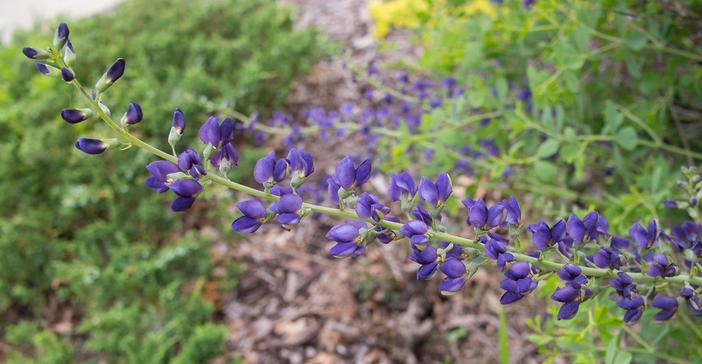Twilite Prairieblues
(Baptisia ×variicolor)
Twilite Prairieblues (Baptisia ×variicolor)
/
/

F. D. Richards
CC BY-SA 2.0
Image By:
F. D. Richards
Recorded By:
Copyright:
CC BY-SA 2.0
Copyright Notice:
Photo by: F. D. Richards | License Type: CC BY-SA 2.0 | License URL: https://creativecommons.org/licenses/by-sa/2.0/ | Uploader: F. D. Richards | Publisher: Flickr

























Estimated Native Range
Summary
Baptisia ×variicolor, commonly known as Twilite Prairieblues or False Indigo, is a hybrid perennial herb resulting from the cross between Baptisia australis and Baptisia sphaerocarpa. This hybrid was developed at the Chicago Botanic Garden to combine the best traits of both parent species. It exhibits a moderate growth rate, reaching heights and widths of 3-4 feet (0.9-1.2 meters). The plant forms an upright, bushy clump with trifoliate leaves and sturdy stems. Twilite Prairieblues is known for its striking flowers, which are a unique blend of purple and yellow, blooming profusely in late spring to early summer. The flowers are quite showy, arranged in elongated racemes, and they can add a dramatic splash of color to the garden.
Twilite Prairieblues is valued for its ornamental flowers, ease of maintenance, and drought tolerance once established. It is commonly used in perennial borders, native plant gardens, and as a specimen plant. It thrives in full sun to part shade and prefers medium to fast-draining soils such as clay, loam, or sandy soils. While it tolerates a range of soil conditions, it does best with regular moisture but can withstand periods of drought. This plant is generally pest and disease-resistant, making it a low-maintenance option for gardeners. However, it can be susceptible to root rot if overwatered or planted in poorly drained soils. It is also deer-resistant, which is an added benefit in areas with high deer populations.CC BY-SA 4.0
Twilite Prairieblues is valued for its ornamental flowers, ease of maintenance, and drought tolerance once established. It is commonly used in perennial borders, native plant gardens, and as a specimen plant. It thrives in full sun to part shade and prefers medium to fast-draining soils such as clay, loam, or sandy soils. While it tolerates a range of soil conditions, it does best with regular moisture but can withstand periods of drought. This plant is generally pest and disease-resistant, making it a low-maintenance option for gardeners. However, it can be susceptible to root rot if overwatered or planted in poorly drained soils. It is also deer-resistant, which is an added benefit in areas with high deer populations.CC BY-SA 4.0
Plant Description
- Plant Type: Herb
- Height: 3-4 feet
- Width: 3-4 feet
- Growth Rate: Moderate
- Flower Color: Blue, Purple, Yellow
- Flowering Season: Spring, Summer
- Leaf Retention: Deciduous
Growth Requirements
- Sun: Full Sun, Part Shade
- Water: Medium
- Drainage: Fast, Medium
Common Uses
Border Plant, Butterfly Garden, Deer Resistant, Drought Tolerant, Low Maintenance
Natural Habitat
Hybrid of garden origin
Other Names
Common Names: False Indigo
Scientific Names: Baptisia ×variicolor
GBIF Accepted Name: